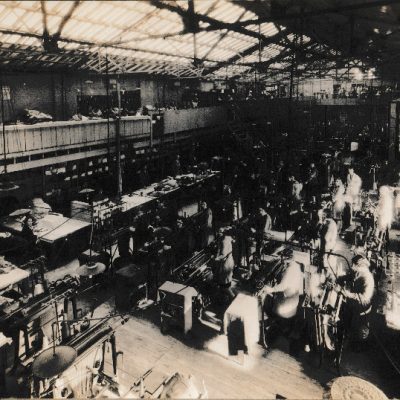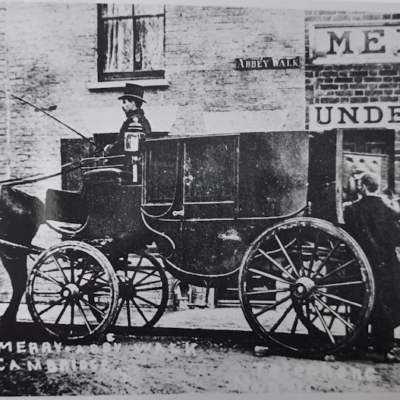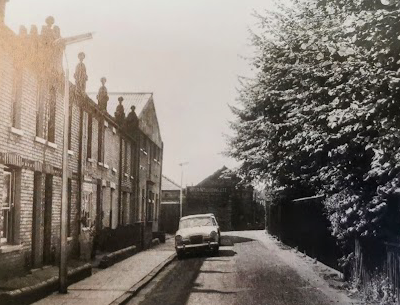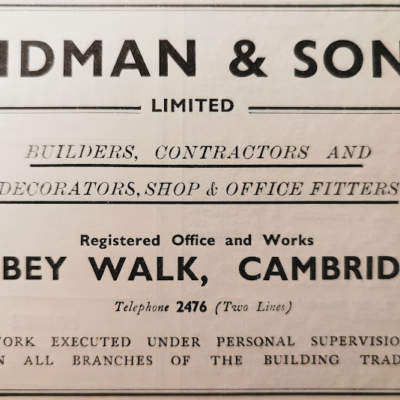Search by topic
- archaeology
- Building of Local Interest
- charity
- church
- crime
- dressmaker
- fire
- Great Eastern Railway
- Listed building
- Mapping Relief
- medieval
- oral history
- poverty
- Public House
- Rattee & Kett
- Religious House
- Roman
- scholar
- school
- Then and Now
- tudor
- women
- work
- world war one
- world war two
Search by text
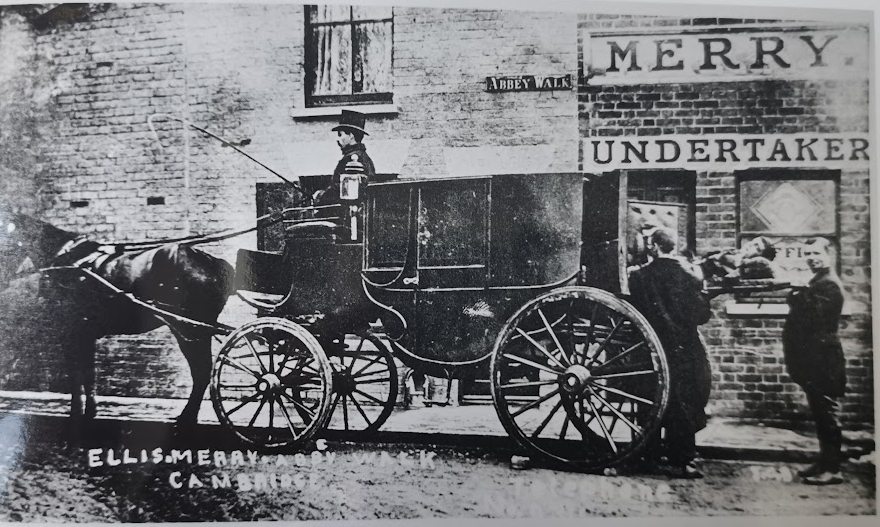 26 - 28 Abbey Walk, Ellis Merry (Cambridgeshire Collection)
26 - 28 Abbey Walk, Ellis Merry (Cambridgeshire Collection)28 Abbey Walk, Strawberry Cottage
A gardener and an undertaker
Abbey Walk was once a much longer street, the main part stretching from Strawberry Cottage all the way to the mini-roundabout that now forms the end of York Street. It was demolished in the 1960s and turfed over to create the eastern part of St Matthew’s Piece. The northern end of York Street – originally straight, not curved – was also demolished.
The east/west part of the present road connecting to York Street was called Fuller’s Walk in the 1881 census. It then had just two cottages, numbered 1 and 2. In the 1891 census they were included in Abbey Walk and referred to already as Vine Cottage and Strawberry Cottage.
1881 census for 2 Fuller’s Walk, York Street
David Smith, head, married, 56, gardener, b. Hertfordshire
Elizabeth Smith, wife, married, 46, b. Norfolk
Agnes Smith, daughter, 21, b. Essex
Charles Smith, son, 18, doctor’s boy (errand), b. Hertfordshire
Arthur Smith, son, 17, b. Cambridge
Mary E. Smith, daughter, 15, b. Cambridge
William Smith, son, 13, scholar, b. Cambridge
Alfred Smith, son, 11, scholar, b. Cambridge
Emily Smith, daughter, 8, scholar, b. Cambridge
Harry Smith, son, 5, scholar, b. Cambridge
Albert Smith, son, 3, scholar, b. Cambridge
Elizabeth Smith, daughter, 1, b. Cambridge
David Smith was from Dane End in southern Hertfordshire, and had moved into Cambridge with his family in the early 1860s.
1891 census for Strawberry Cottage, Abbey Walk
Ellis Murray [Merry], head, 36, cab proprietor, b. Tottenham, London
Caroline Murray, wife, 34, b. Cambridge
Nelly Summerfield, niece, 4, b. Cambridge
Ellis Merry was born in London but his father James came from Cherry Hinton. Ellis and his siblings were brought up in Cambridge.
He was an active member of the Salvation Army. In 1885 he was summoned to court by Harry Ward, publican of the Six Bells in Covent Garden, who objected to a Salvation Army band singing outside his pub (Cambridge Independent Press, 3 October 1885, page 8). Ward identified Merry as the ringleader of a group of 100 Salvationists, ‘kicking up a great row’, breaking bye-laws and disturbing his children and invalid father. The defence lawyer noted the hostile nature of the witness statements and lack of legal evidence, and said ‘it seemed a remarkable fact that a publican should prosecute a member of an association which was formed for the purpose of making men teetotalers.’ The case was thrown out.
1901 census for Strawberry Cottage, Abbey Walk
Ellis Merry, head, 46, cab proprietor and undertaker, b. Tottenham, London
Caroline Merry, wife, 43, b. Cambridge
Lilian Mansfield [Mansley], niece, 16, b. Sunderland, Durham
Nellie Summerfield, niece, 14, b. Cambridge
Ellis and Caroline Merry had no children of their own. Nellie Summerfield was the daughter of Caroline’s sister Mahala, who lived with her husband William Summerfield and younger children just a short walk away at 12 Geldart Street. Lilian Mansley was the daughter of Ellis’s sister Tammerson, who had settled down in northern England.
Ellis Merry started his career as a cab proprietor but diversified into the funeral business. From 1899 he ran regular adverts in the local newspapers, listing his charges for a glass hearse and carriages. From 1917 he advertised a motor hearse.
He also used his fleet of vehicles for public service. Every summer (see e.g. Cambridge Daily News, 2 August 1899) he would take 50 inmates of the workhouse for a country drive followed by tea. In the summer of 1902 he turned the country drives into a business venture, advertising daily drives into Cambridgeshire villages for a fare of 1 shilling (see e.g. Cambridge Daily News, 26 July 1902).
He was active in local politics for the Liberal party. In 1908 he addressed a protest meeting by local cabmen, concerned that the town council was planning to grant licenses to ten motor taxi-cabs owned by a company in London (Cambridge Independent Press, 16 October 1908). He asked what use the taxi-cabs would be: ‘Were they to be placed on the streets simply to please a few people’s whims and fancies? (Hear, hear.)’ He noted that many cabmen had to work 18 hours a day, and might average less than two fares a day. As many as 500 might be thrown into poverty.
1911 census for 28 Abbey Walk
Ellis Merry, head, 56, undertaker, b. Tottenham, London
Caroline Merry, wife, 53, b. Cambridge
Lizzie Woolfenden, widow, 30, companion (domestic), b. Trumpington, Cambridgeshire
Married 34 years
In 1915 Ellis and Caroline narrowly avoided becoming the victims of a bizarre scam – and possibly murder (see e.g. Cambridge Independent Press, 28 May 1915, page 7*). A young man called Clifton Stiles, aware that Ellis wanted to retire and try his luck in local politics, made an offer to buy the funeral business. He persuaded Ellis and Caroline to drive to Hauxton with him to meet an elderly couple who had offered to give him £2500. However, he chose go via a remote lane in which the motor car got stuck in mud and had to be pulled out. He then called at his benefactors’ house and reported back that the elderly lady was very ill, so they all returned to Cambridge. Growing suspicious, Merry made enquiries and discovered that the benefactors did not exist. He then found that documentation for the deal, which he had put in his own safe, contained a skilfully forged will in which he left his entire estate to Stiles. At this point Merry decided to call the police. Clifton Stiles was tried and found guilty of fraud. Had he intended to murder Ellis and Caroline Merry during their country drive? Did he have accomplices who failed to turn up? Or, as argued by his defence, did the evidence point more to ‘an irresponsible kind of freak than anything in the nature of fraud’? Stiles was sentenced to seven years’ penal servitude but died in 1919 before his time was completed.
In 1918 Ellis found a more suitable person to take over his business: Edward William Harper, a former Salvation Army officer (Cambridge Daily News, 16 December 1918). For some years they ran the business as a partnership, and then Edward took it over in the 1920s.
Caroline Merry died in 1935 and Ellis in 1937. They are buried in the churchyard of St Andrew, Cherry Hinton.
* The Cambridge Independent Press account of Clifton Stiles’ trial (28 May 1915, page 7) mentions that the ‘Mission Hall’ was to be excluded from the sale of Ellis Merry’s business. This suggests that Ellis Merry had some involvement with the People’s Mission Hall on Abbey Walk. This hall was behind the Dobblers Inn and was often mentioned in local newspapers from the 1900s and 1910s, mainly in relation to social events.
Trade directories of 1913 for 26 and 28 Abbey Walk list Ellis Merry as jobmaster, undertaker and funeral carriage proprietor.
1921 census for 28 Abbey Walk
Edward W V Harper, head, 45, jobmaster & undertaker, employer, b. Norwich, Norfolk
Eliza Jane Harper, wife, 46, housewife, b. Camborne, Cornwall
Lilian Dorothy Harper, daughter, 18, mother’s help, b. Kettering, Northamptonshire
1939 England and Wales register
Alice M Harper, 22 Jan 1908, married, housewife & undertaker’s wife
Two closed records: children born since 1921
Richard G Harper, 13 Feb 1938, under school age
By 1939 Edward William Harper had retired and handed the business over to his son Edward John Harper. Alice M Harper, resident in 1939, was Edward junior’s wife.
In 1948 the company was J O’Hannan & Sons Ltd, funeral directors and monumental masons. By 1960 it was Weyman Funeral Service, as it still is today.
Sources
UK census records (1841 to 1911), General Register Office birth, marriage and death indexes (1837 onwards), the 1939 England and Wales Register, electoral registers, trade directories, and local newspapers available via www.britishnewspaperarchive.co.uk.
Contribute
Do you have any information about the people or places in this article? If so, then please let us know using the Contact page or by emailing capturingcambridge@
License
This work is licensed under CC BY-NC-SA 4.0






